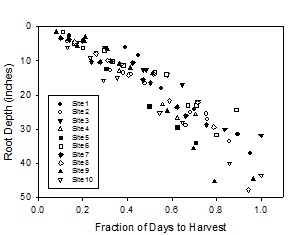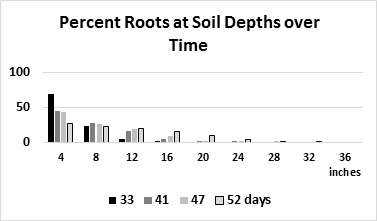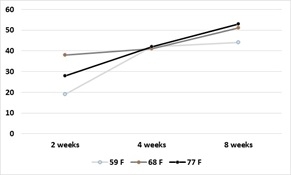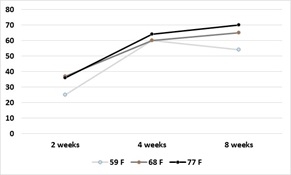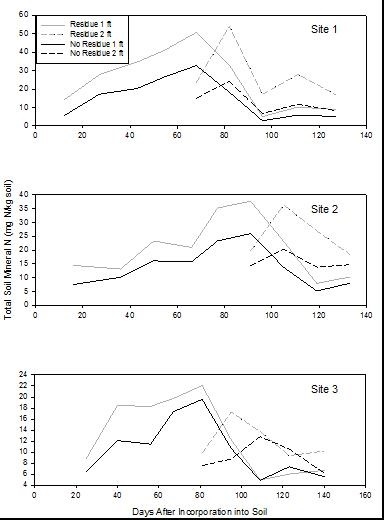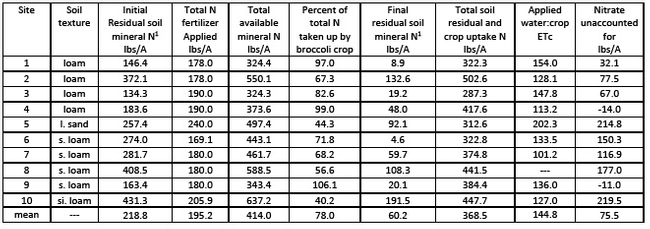Summary: The ability of broccoli to scavenge N from depths below 2 feet was evaluated in 2014 and 2015. Broccoli roots extend down to three feet in the soil by the end of the crop cycle. Broccoli is capable of scavenging nitrogen from the 2nd and 3rd foot in the soil, but adequate nitrogen is required to help develop the crop at an early stage for broccoli to achieve maximum yield. Most scavenging of nitrate deeper in the soil profile occurs in the final third of the crop cycle. In a survey of 10 broccoli fields following a prior lettuce crop broccoli took up >80% of the residual + fertilizer N in 4 of these fields. If residual soil nitrate levels are not too high, broccoli can take up a high percent of the N mineralized from the residue of the previous lettuce crop and reduce levels of soil nitrate that is at risk of leaching. Broccoli residue also mineralizes rapidly and releases large quantities of nitrate that could provide for the N needs of a subsequent crop.
Background:Summer-grown broccoli and other cole crops such as cauliflower and cabbage have been shown to routinely take up more nitrogen than is typically applied as fertilizer. This indicates that these crops scavenge excess nitrogen from the soil profile. They are deep rooted and utilize soil nitrate in the second and even the third foot of soil. The phenomenon of scavenging is not unique to the cole crops, as we have observed scavenging in some fields of peppers, celery and lettuce. The question is, however: Where does the residual soil nitrate that these crops scavenge come from?
Residual levels of soil nitrates comes from several sources: mineralization of soil organic matter and prior crop residues, unused N from fertilizers applied to prior crops and nitrate in irrigation water. In warm summer soils, nitrate is the main form of mineral N in the soil and typically ranges from 5 to 30 ppm nitrate-N. Soil ammonium-N levels in the soil in the summer are much less and typically range from 1 to 3 ppm. The nitrate molecule has a negative charge and is not adsorbed onto soil colloids, but rather resides in moisture held in soil pores. As such, nitrate is at risk to be transported below the rooting zone of crops with excess water from irrigation or rainfall. It is therefore best to measure soil nitrate immediately prior to making fertilizer decisions. For this reason, the nitrate quick test is the most common method of measuring soil nitrates in our cool season vegetable area because it allows growers to get the results of soil nitrate levels quickly in order to make fertilizer application decisions.
Residual soil nitrate levels must be high enough to effectively supply a fast growing cool season vegetable. A sufficiency threshold of 20 ppm nitrate-N was first proposed for cool season vegetable crops by Tim Hartz, which if measured in the first foot of soil, is equivalent to 76 lbs N/acre. This quantity of nitrogen is sufficient to supply the immediate needs of the vegetable crop for two to three weeks.
Nitrogen Scavenging Studies: Uptake of N from various depths in the profile. In 2014-15 we evaluated fertilization strategies of broccoli and its ability to scavenge residual soil nitrate from the soil following a lettuce crop. Broccoli roots were found to reach three feet deep in the soil by the end of the cropping cycle (Figure 1). To evaluate the ability of broccoli to utilize nitrogen from deeper in the soil profile, we conducted a trial at the USDA Spence Research Station in which we applied nitrogen using drip tape placed on the surface, and at depths of 12, 18 and 24 inches using equipment for injecting drip tape below the soil surface. The soil profile was low in residual soil nitrate at the beginning of the trial and the same quantity of N (150 lbs N/A) was applied to all the treatments. Fertilizer treatments were applied 27, 38 and 48 days after the first germination water.
The yield was lower in the treatments where the fertilizer was applied at 12 & 18 inch deep in the soil and was particularly low where it was applied 24 inches deep (data not shown). Because it takes time for broccoli roots to grow down through the soil profile, it appears from these results that the early growth suffered from lack of nitrogen, since the root system was not adequately developed to take up the fertilizer from deeper in the soil profile. These results suggest that broccoli needs an adequate supply of N in the upper foot during the early stages of development, even when an ample N may be available deeper in the soil.
Uptake of residual soil N by broccoli: We also studied the ability of broccoli to take up residual soil nitrate left over from the prior lettuce crop. We surveyed a total of 10 fields over two years, evaluating the amount of residual soil nitrate at the beginning of the broccoli cropping cycle. Nitrogen was measured in the top three feet to account for the total amount of nitrogen accessible to the crop. The levels of soil nitrate in the top three feet of soil at the beginning of the broccoli cropping cycle ranged from 134 to 431 lbs N/A (Table 1). This wide variation in the range may have to do with fertilizer practices in the prior lettuce crop and N mineralized from crop residues. Fertilizer applications to the broccoli crops ranged from 169 to 240 lbs N/A, and the ratio of applied fertilizer N to crop N uptake ranged from 0.48 to 1.09.
The percent of initial mineral N taken up by the broccoli crop ranged from 40 to 106%, with four out of the ten sites having N uptake by the broccoli crop of greater than 82% uptake of initial residual soil nitrate + fertilizer N. The amount of residual soil nitrate left in the top three feet following the broccoli crop ranged from 9 to 192 lbs N/A. The results from this sampling of broccoli fields show that, under the right conditions, broccoli can take up a large percentage of the residual soil nitrogen left by a previous lettuce crop. However, if residual soil nitrate levels are too high, broccoli will not be able to absorb a large percent of the initial load.
In Table 1, the last column shows the levels of nitrate unaccounted-for. This estimate probably reflects leached nitrate. In all sites with unaccounted nitrate levels of >100 lbs N/A, the total amount of mineral N available for the crop (initial residual nitrate + fertilizer) was >440 lbs N/A. The ratio of crop water applied to crop ETc ranged from 1.0 to 2.1, but sites with the highest potential leaching did not necessarily correlate with the more efficient irrigation ratios.
On-farm evaluation of N uptake from 2nd foot of soil: We conducted an on-farm evaluation to see if 2nd-foot soil samples could be used to guide fertilizer application decisions. This trial was conducted to refine the algorithms used in CropManage (CM) to guide water and fertilizer decisions for broccoli. Table 2 shows the quantities of fertilizer applied to the CM and standard treatments. The quantities of fertilizer at each application date were based on soil nitrate quick tests. In total, 56% less fertilizer was applied to the CM treatment. However, the CM treatment also had 4% lower commercial yield than the standard treatment. At the first fertilization, we reduced the fertilizer application in the CM treatment by 44 lbs N/A because of adequate levels of residual soil nitrate in the first foot of soil; subsequent to this application, the soil nitrate levels between CM and the standard treatment did not differ, and we do not think that reducing the N application in this fertilizer event affected the yield of broccoli. On the next application date, at 49 days after planting, 44 lbs N/A were applied in the standard treatment, but no N was applied to the CM treatment because the soil nitrate levels in the 2nd foot were at 25 ppm nitrate-N. We suspect that the observed yield reduction in the CM treatment may have been because the level of nitrate in the upper foot was too low and the root system was not yet sufficiently developed to take up the N from the 2nd foot. In 2015, we observed that 28% of the roots were in the 2nd foot of soil at 52 days after planting (Figure 2), and this level of root activity may not be adequate to utilize deep soil nitrate to support rapid top growth of the crop.
Broccoli residue as a source of N: At harvest, 25-30% of broccoli biomass leaves the field as the harvested product. Given that summer-grown broccoli takes up >330 lbs N/acre, a substantial quantity of nitrogen remains in the field after harvest. For broccoli residue with high N content (5% N), more than 60% of the N is mineralized 4 weeks after incorporation into the soil. Broccoli residues with lower N content (3.75% N) will release about 40% of the N by 4 weeks after incorporation into the soil. (Figures 3a and 3b). Figure 4 shows the results of N mineralization of broccoli residues in the field. Soil nitrate levels were evaluated in plots with and without broccoli residue. Soil nitrate-N levels peaked between 22 to 50 ppm. After the peaks, the levels declined due to rain events that leached the nitrate deeper in the soil profile (Figure 5). Soil nitrate concentrations peaked in the 2nd foot of soil after the decline in concentration in the 1st foot. Later, nitrate was leached from the 2nd foot to deeper in the soil profile. The levels of nitrate mineralized from broccoli residues are substantial and can potentially substitute for a substantial amount of the fertilizer N of a subsequent crop if it is not leached due to a major rain or irrigation event.
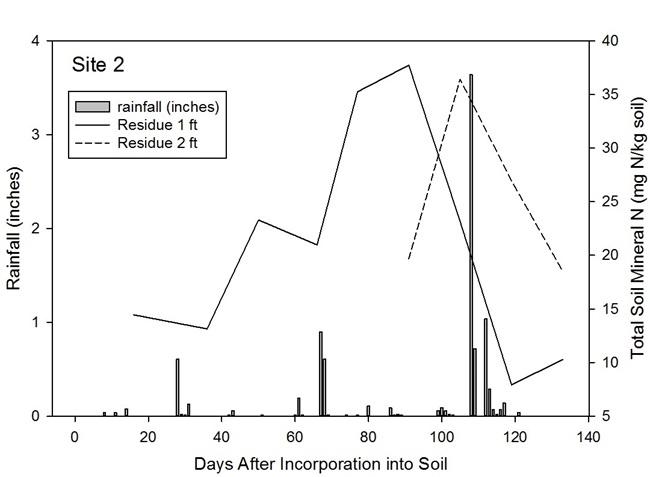
Table 1. Analysis of total N available from residual soil N and fertilizer, broccoli N uptake and its impact on N utilization and nitrate leaching
Table 2. Applied fertilizer and biomass of CropManage vs standard and unfertilized treatments.
